Transmission Fluid Cooler Flushing and Flow Test Flushing Procedure
Notice: Whenever you remove the transmission for service, you must perform the automatic transmission oil cooler flushing procedure in order to remove the existing fluid which may be contaminated. This will prevent contamination of the new fluid. You must perform the flushing procedure after the installation of the overhauled or replacement transmission.
After filling the transaxle with fluid, start the engine and run for 30 seconds. This will remove any residual moisture from the oil cooler. Disconnect the return line at the transaxle and observe the flow with the engine running. If the fluid flow is insufficient, test the fluid flow by disconnecting the feed line at the cooler. Observe the flow with the engine running.
| • | If the flow from the cooler return line at the transaxle is insufficient, observe the flow rate from the feed line to the cooler. Blockage may exist in the transaxle or the cooler. |
| • | If the flow from the transaxle feed line to the cooler is insufficient, the transaxle is the cause of the fluid flow problem. |
| • | If the flow from the transaxle feed line to the cooler is sufficient but flow from the cooler return line to the transaxle is insufficient, inspect the cooler pipes and fittings. Repeat the cooler flushing procedure described above. If the flow is still insufficient, replace the cooler. |
Transmission Fluid Cooler Flushing and Flow Test J-45096
GM studies indicate that plugged or restricted transmission oil coolers and pipes cause insufficient transmission lubrication and elevated operating temperatures which can lead to premature transmission failure. Many repeat repair cases could have been prevented by following published procedures for transmission oil cooler flushing and flow checking. This procedure includes flow checking and flushing the auxiliary transmission oil cooler, if equipped.
Important: Use the J 45096 or equivalent to flush and flow test the transmission oil cooler and the oil cooler pipes after the transaxle is removed for repairs.
The tool may be adapted for use on this vehicle by dealership personnel with a barbed hose connector and rubber hose obtained locally. This transmission has a transmission oil requirement which maybe slightly different than DEXRON® III ATF. However, flushing the cooler with DEXRON® III automatic transmission fluid is an acceptable service procedure. Very little fluid remains in the cooler after the flush procedure and the residual DEXRON® III ATF in the cooler is compatible with this vehicle's transmission fluid.
Important: Only use the specified automatic transmission fluid after doing a repair on this transmission. Refer to Fluid and Lubricant Recommendations
Cooler Flow Check and Flushing Steps
- Machine Set-up
- Determine Minimum Flow Rate
- Back Flush
- Forward Flush
- Flow Test
- Code Recording Procedure
- Clean-up
Tools Required
| • | J 45096 Transmission Oil Cooling System Flush and Flow Test Tool |
| • | Shop air supply with water/oil filters, regulator and pressure gage -- minimum 90 psi |
| • | Eye protection |
| • | Rubber gloves |
Machine Set-up
- Verify that the main power switch (1) is in the OFF position.
- Place the main function switch (2) in the IDLE position.
- Connect J 45096 to the vehicle 12-volt DC power source by connecting the red battery clip to the positive (+) battery post on the vehicle and connect the negative (-) lead to a known good chassis ground.
- Turn the main power switch to the ON position.
- Fill the supply tank with Dexron®III or equivalent, through the fill port.
- Install and tighten the fill cap.
- Connect a shop air supply hose to the quick-disconnect on the rear panel marked SUPPLY AIR.
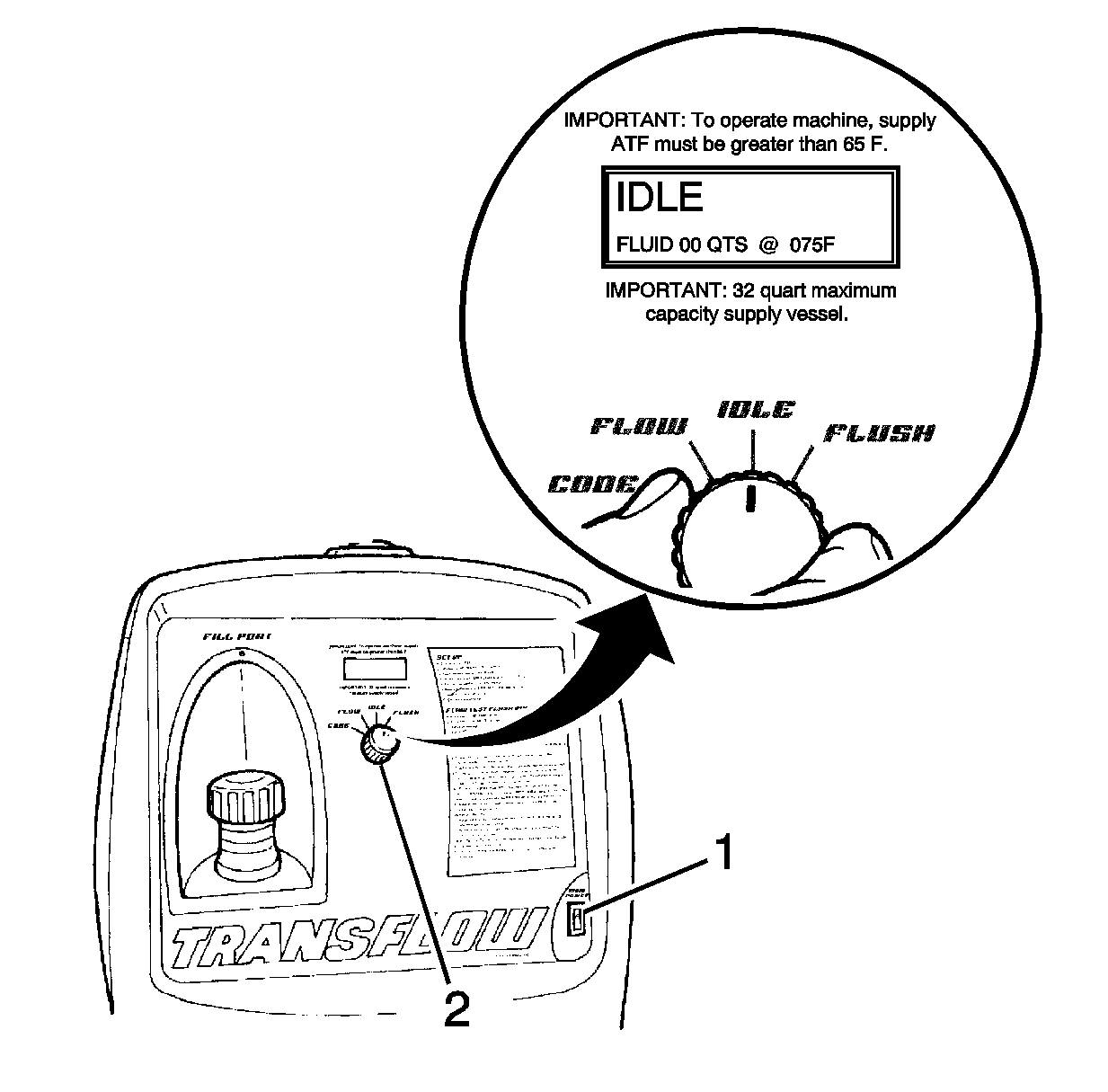
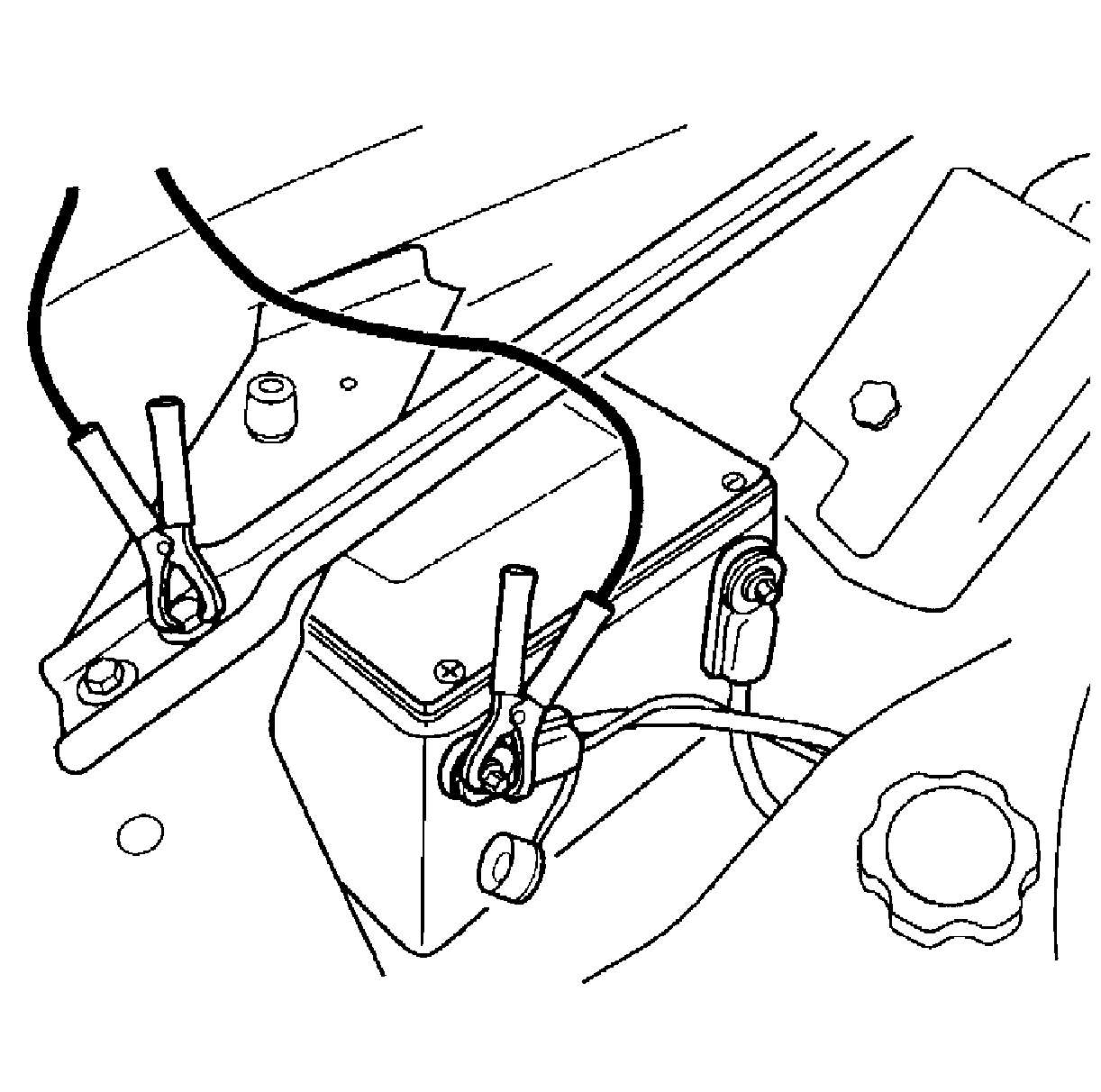
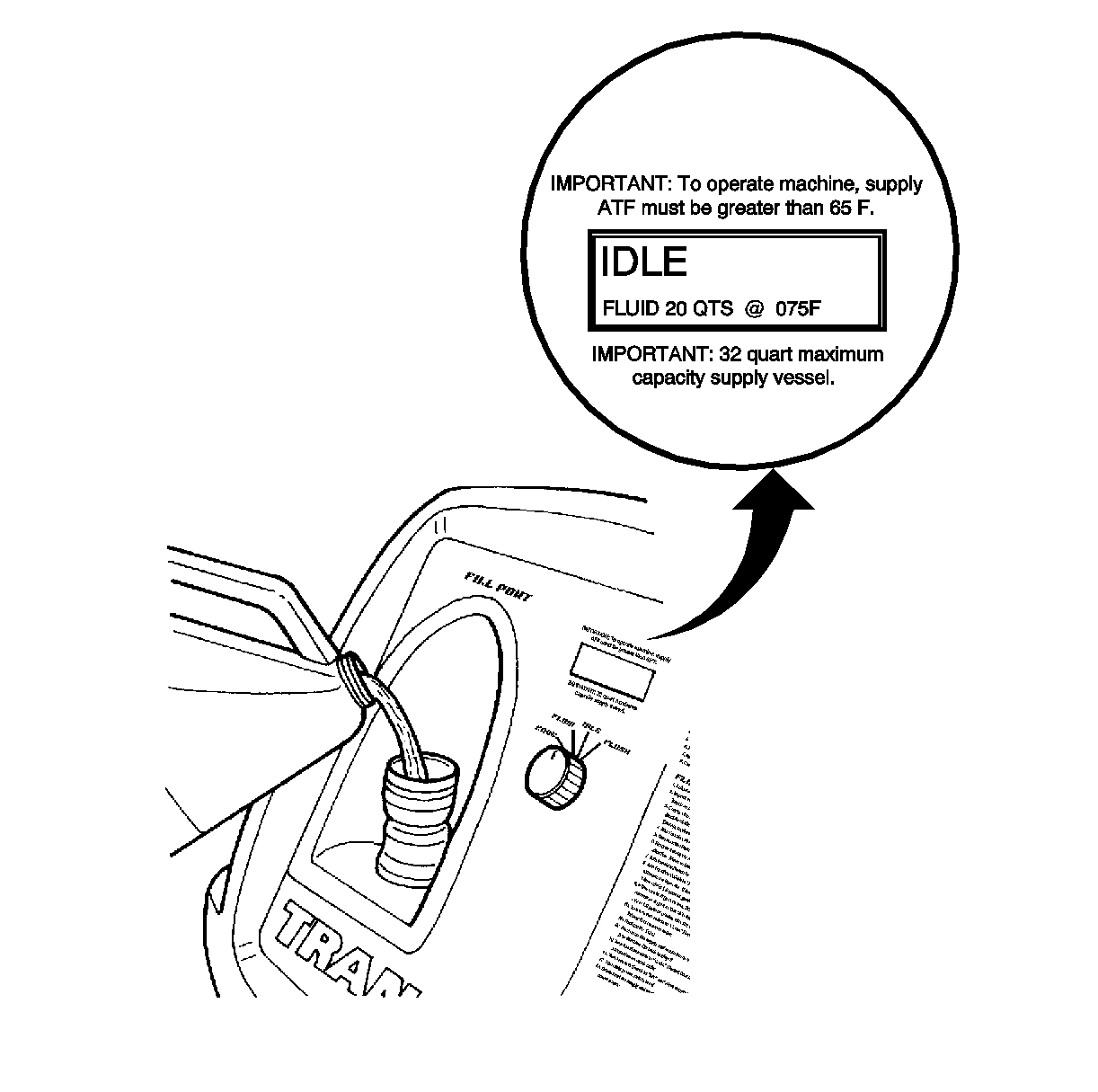
Notice: Do not overfill the supply vessel. Damage to the unit may result. To verify the fluid level, view the LCD screen display while filling the unit, to ensure the fluid level does not exceed 30 L (32 qt).
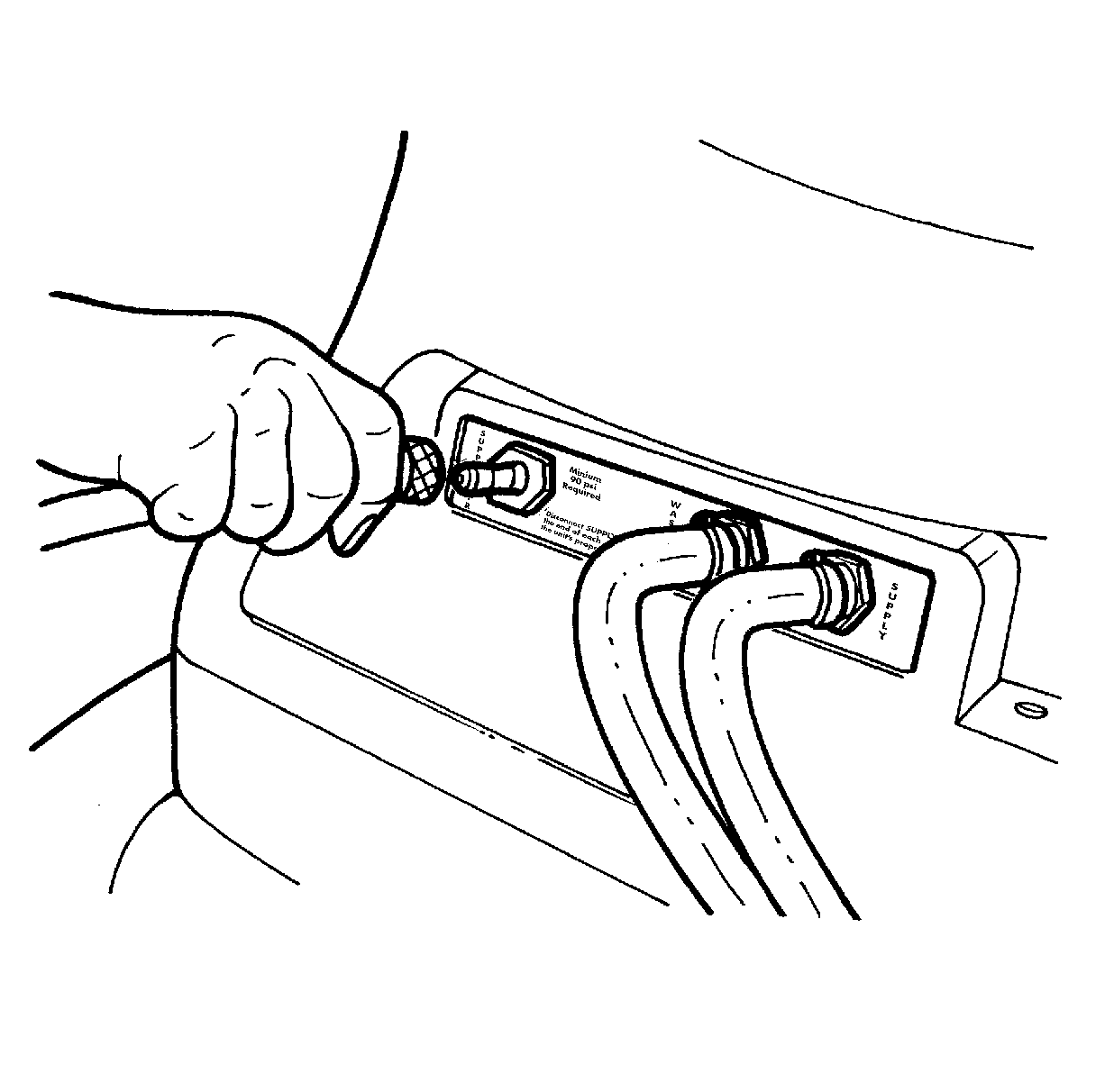
Determine Minimum Flow Rate
- From the machine display, identify the temperature of the automatic transmission fluid that is stored in the supply vessel of J 45096 .
- Determine whether the transmission oil cooler is steel or aluminum by using a magnet (1) at the cooler flange (2) at the radiator.
- Refer to the table below. Using the temperature from step 1, locate on either the Steel MINIMUM Flow Rate table or the Aluminum MINIMUM Flow Rate table the minimum flow rate in gallons per minutes (GPM). Record the minimum flow rate in GPMs and the supply fluid temperature for further reference.
- Inspect transmission oil cooler lines for damage or kinks that could cause restricted oil flow. Repair the lines as necessary.
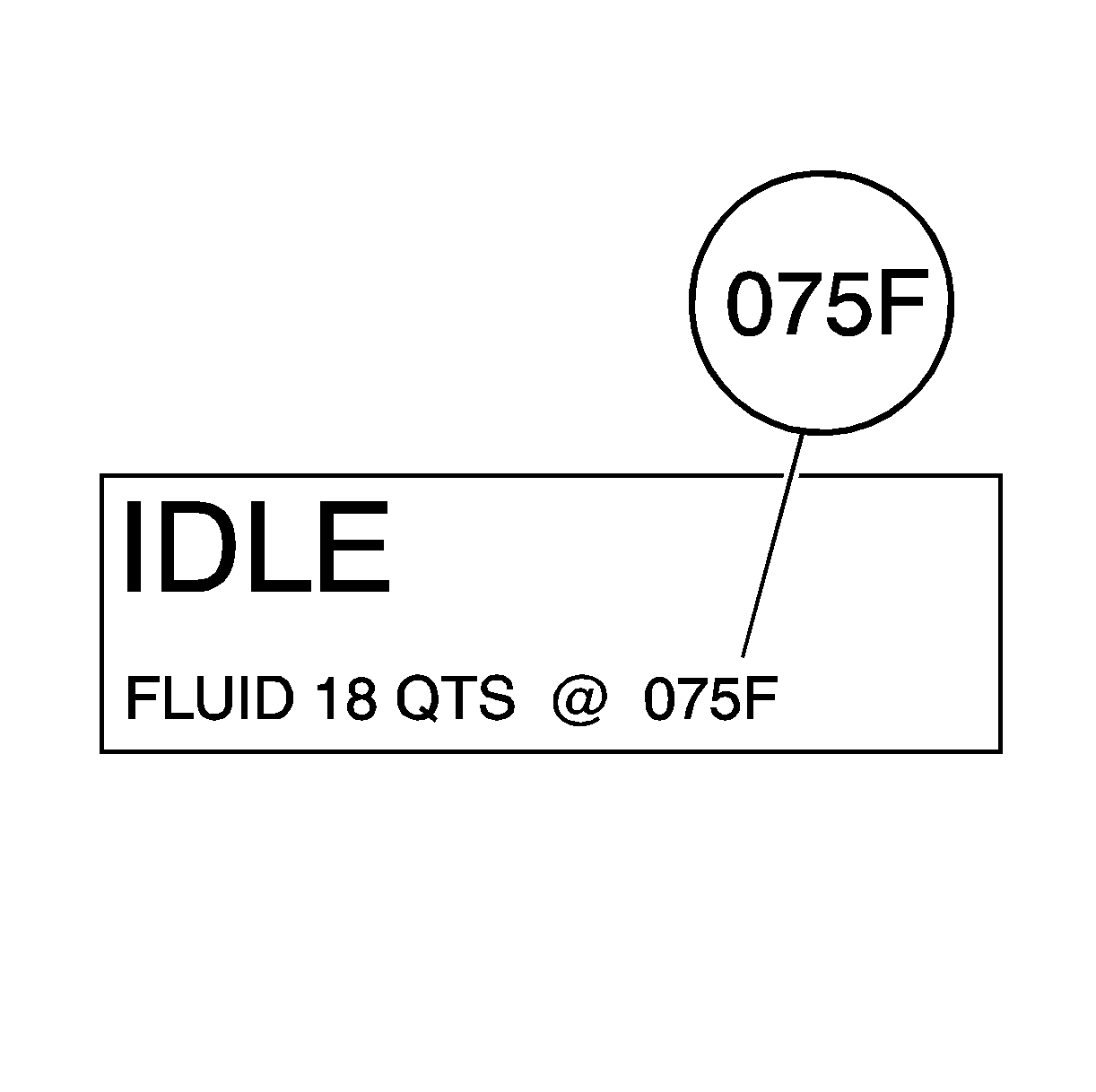
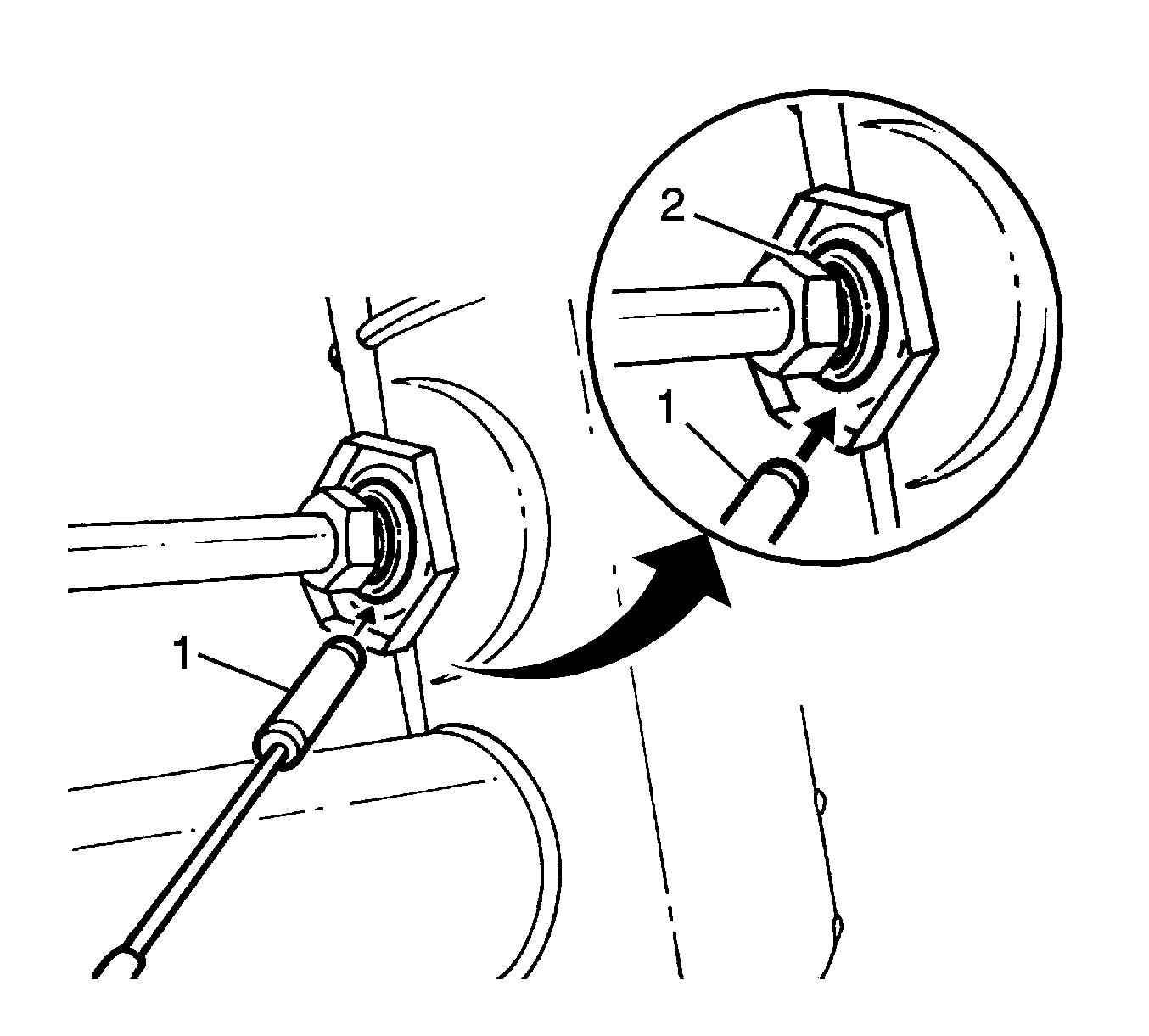
Example:
| • | Fluid temperature: 75°F |
| • | Cooler type: Steel |
| The MINIMUM flow rate for this example would be 0.8 GPM. |
Temperature Range | Steel | Aluminum |
|---|---|---|
65-66°F | 0.6 gpm | 0.5 gpm |
67-70°F | 0.7 gpm | 0.6 gpm |
71-75°F | 0.8 gpm | 0.7 gpm |
76-80°F | 0.9 gpm | 0.8 gpm |
81-84°F | 1.0 gpm | 0.9 gpm |
85-89°F | 1.1 gpm | 1.0 gpm |
90-94°F | 1.2 gpm | 1.1 gpm |
95-98°F | 1.3 gpm | 1.2 gpm |
99-103°F | 1.4 gpm | 1.3 gpm |
104-108°F | 1.5 gpm | 1.4 gpm |
109-112°F | 1.6 gpm | 1.5 gpm |
113-117°F | 1.7 gpm | 1.6 gpm |
118-120°F | 1.8 gpm | 1.7 gpm |
Back Flush Procedure
- Connect the J 45096 adapters (1) to the vehicle's transmission oil cooler supply and return lines at the transmission, may require J 35944-200 .
- Connect the black supply hose (1) to the return line, top connector of the transmission, and the clear waste hose (2) to the feed line, bottom connector of the transmission, to the vehicle cooler lines. This is the reverse flow-backflush direction.
- Turn the main function switch to the FLUSH position. Allow the machine to operate for 30 seconds.
- Turn the main function switch to the IDLE position and allow the supply vessel pressure to dissipate.
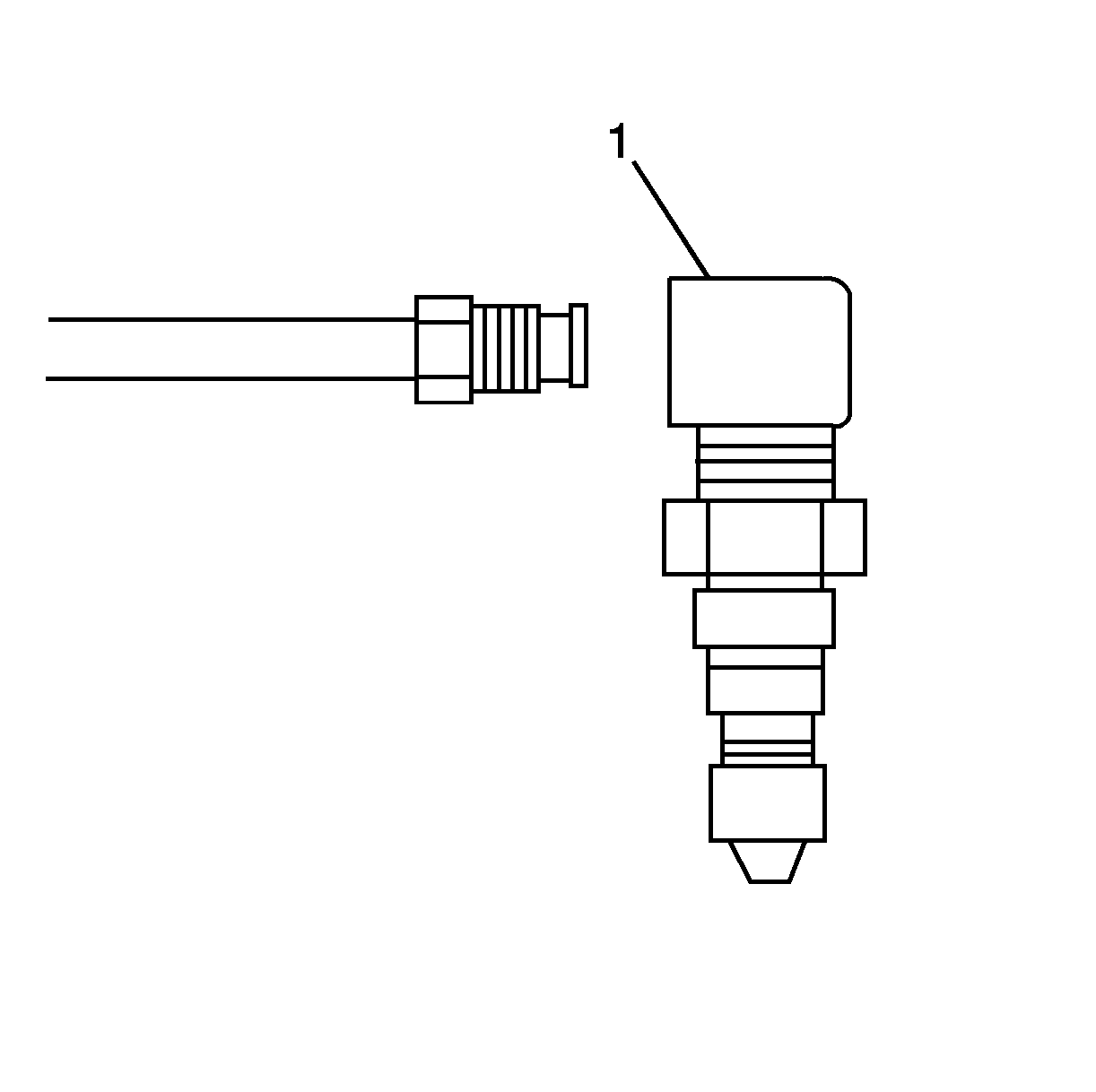
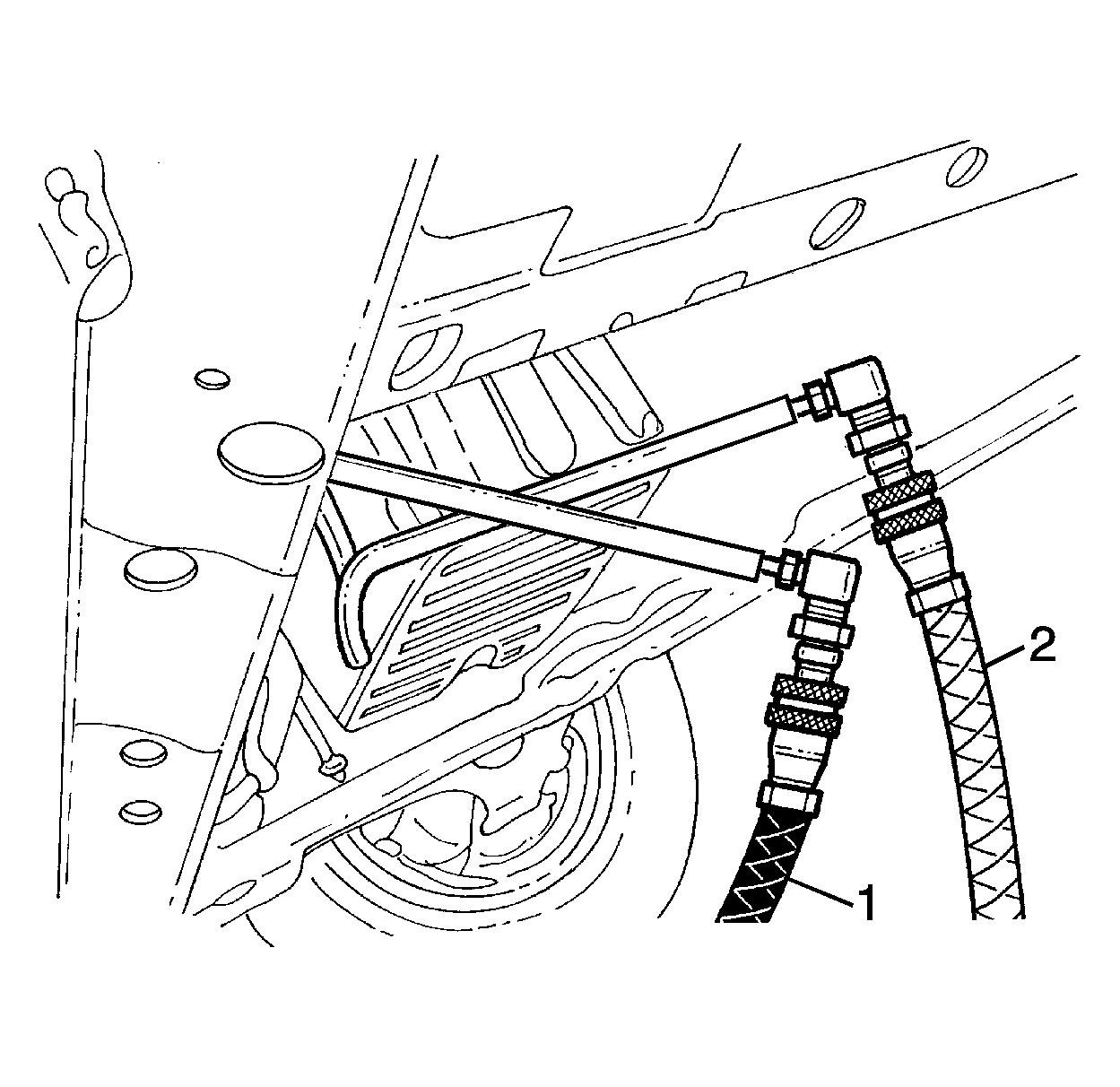
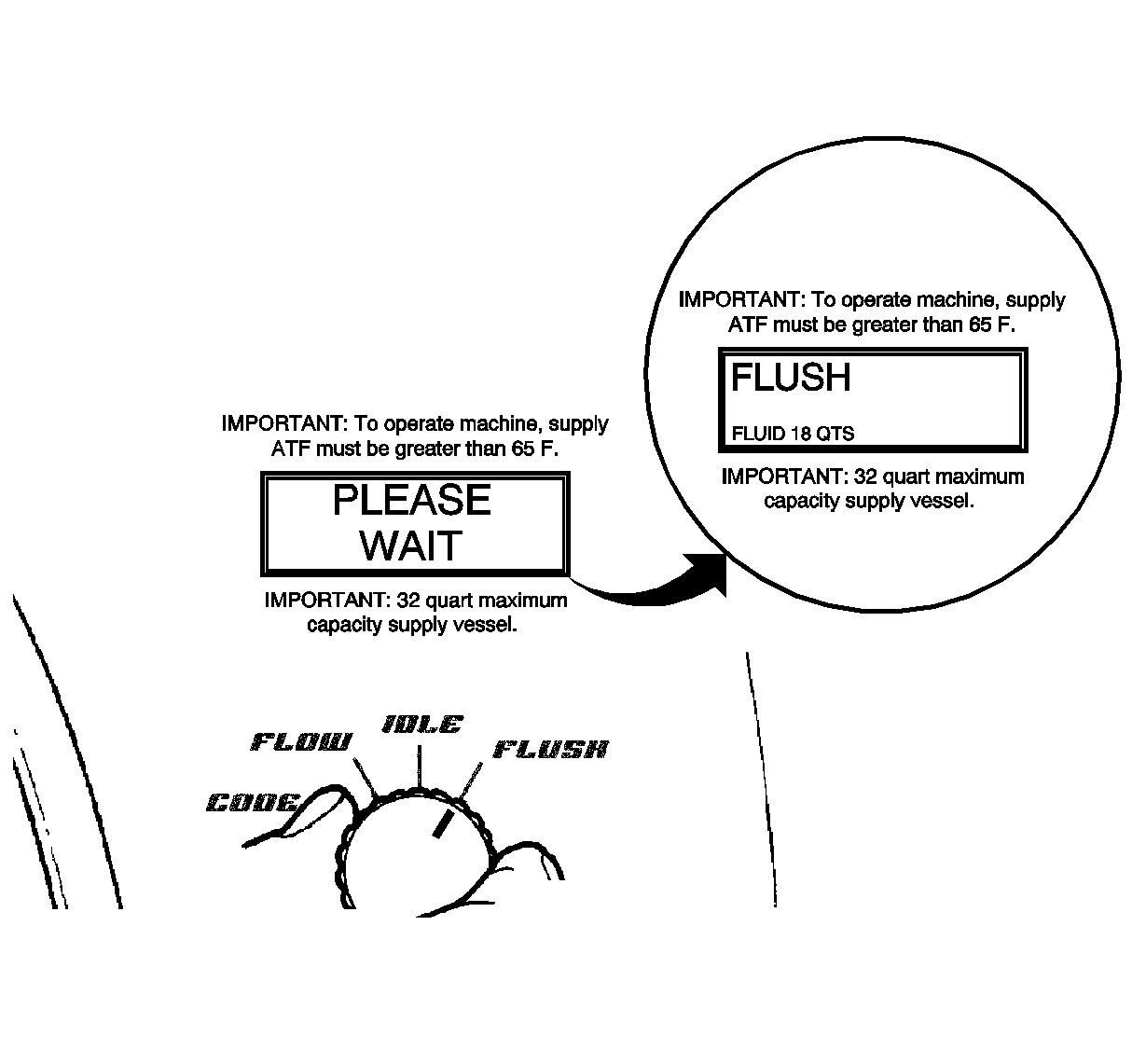
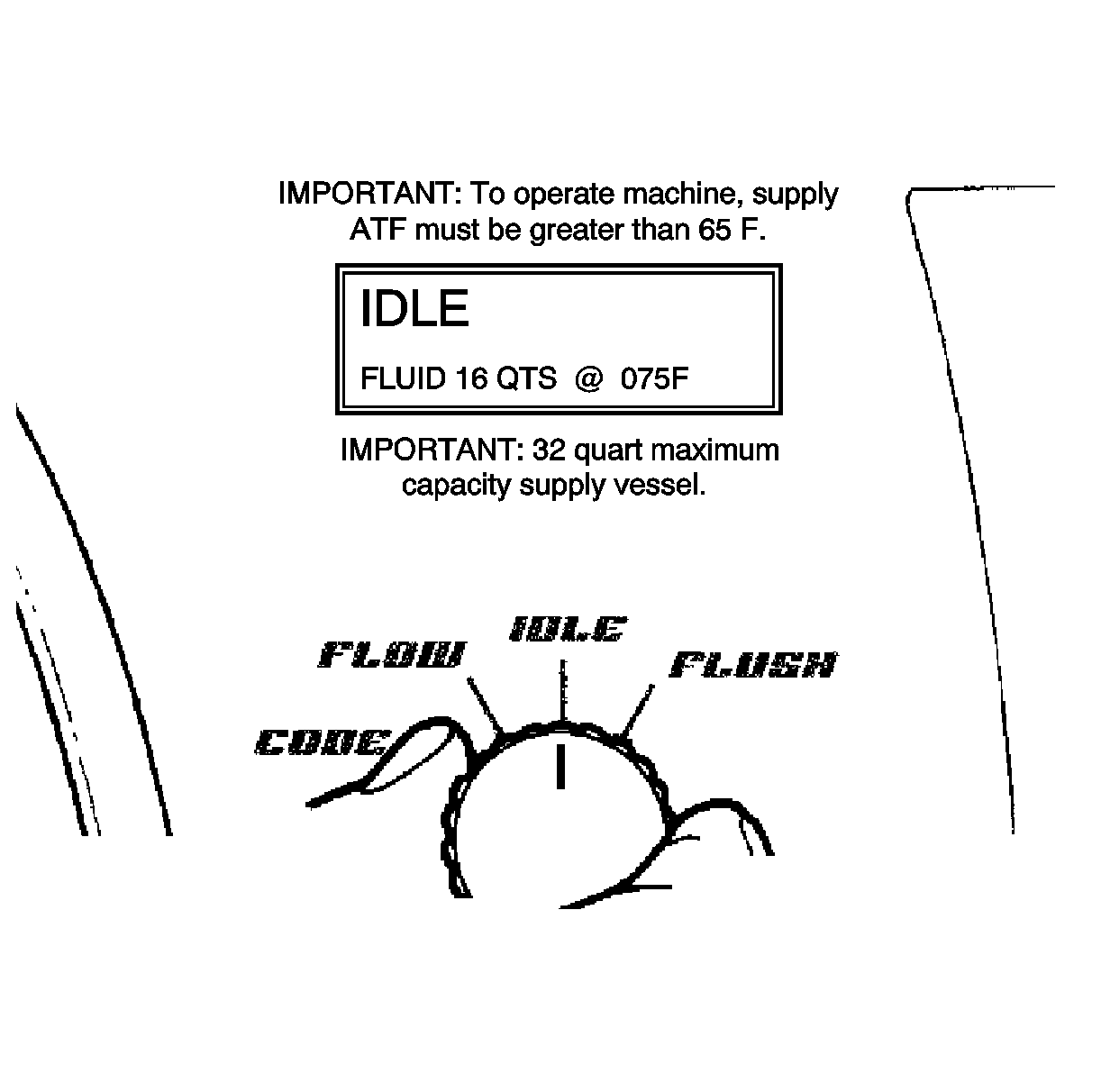
Forward Flush
- Disconnect the supply and waste hoses from the vehicle cooler lines. Reverse the supply and waste hoses to provide a normal flow direction.
- Turn the main function switch to the FLUSH position and allow the machine to operate for 30 seconds.
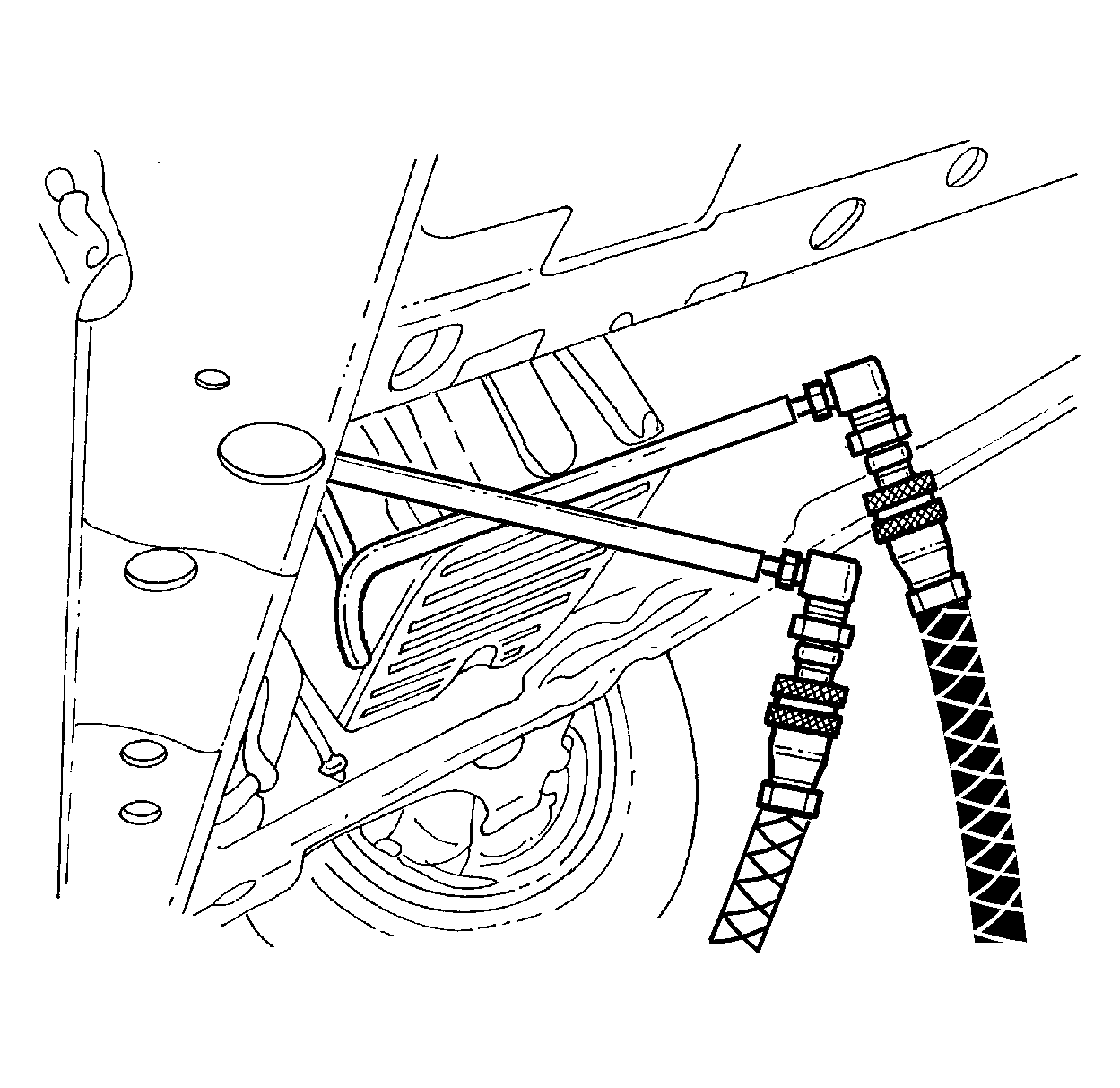
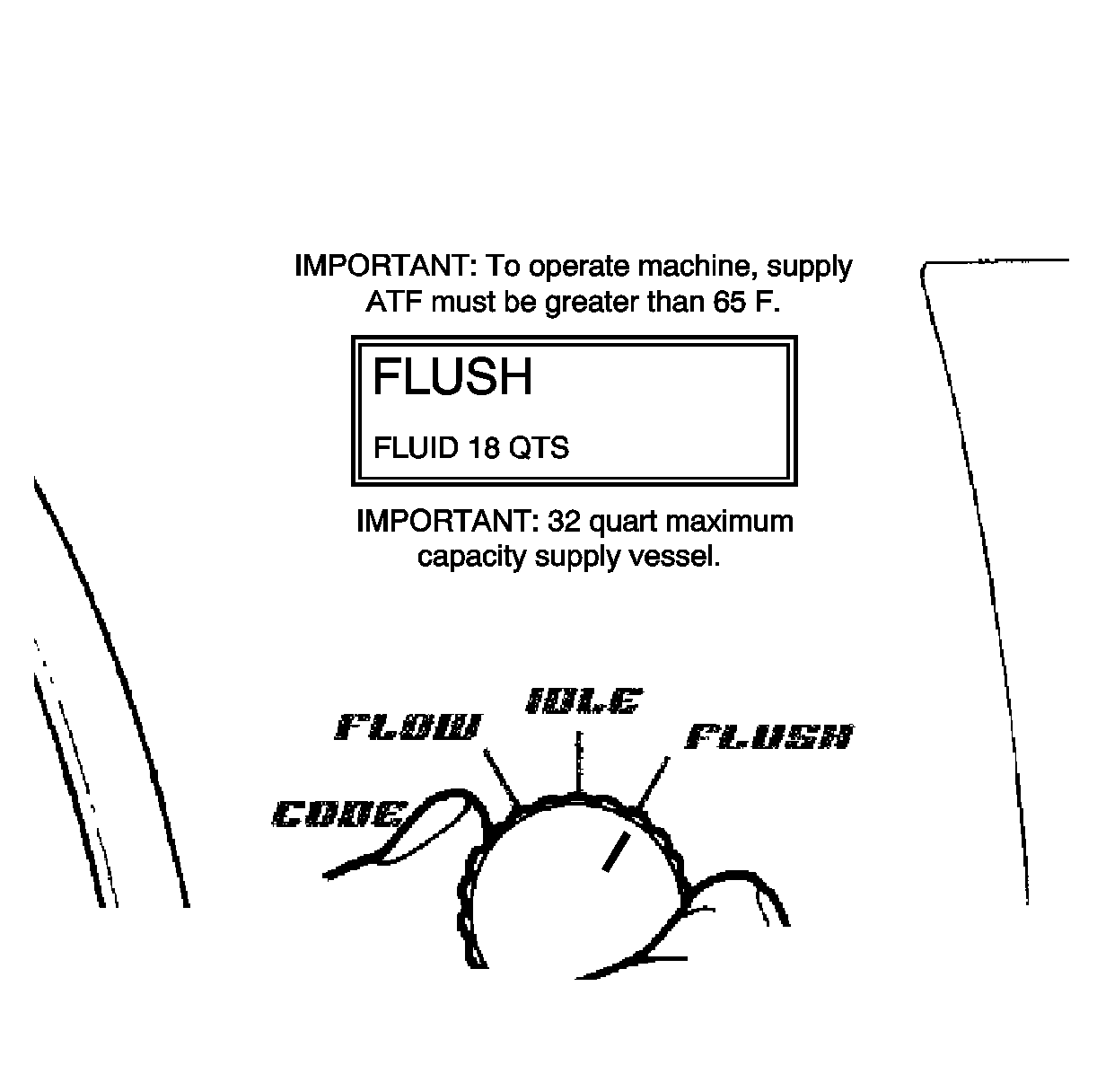
Flow Test
- Turn the main function switch to the FLOW position and allow the oil to flow for 15 seconds. Observe and note the flow rate. This is the TESTED flow rate.
- Compare the TESTED flow rate to the MINIMUM flow rate information previously recorded.
- If the TESTED flow rate is less than the MINIMUM flow rate after the second test, perform the Code Recording Procedure.
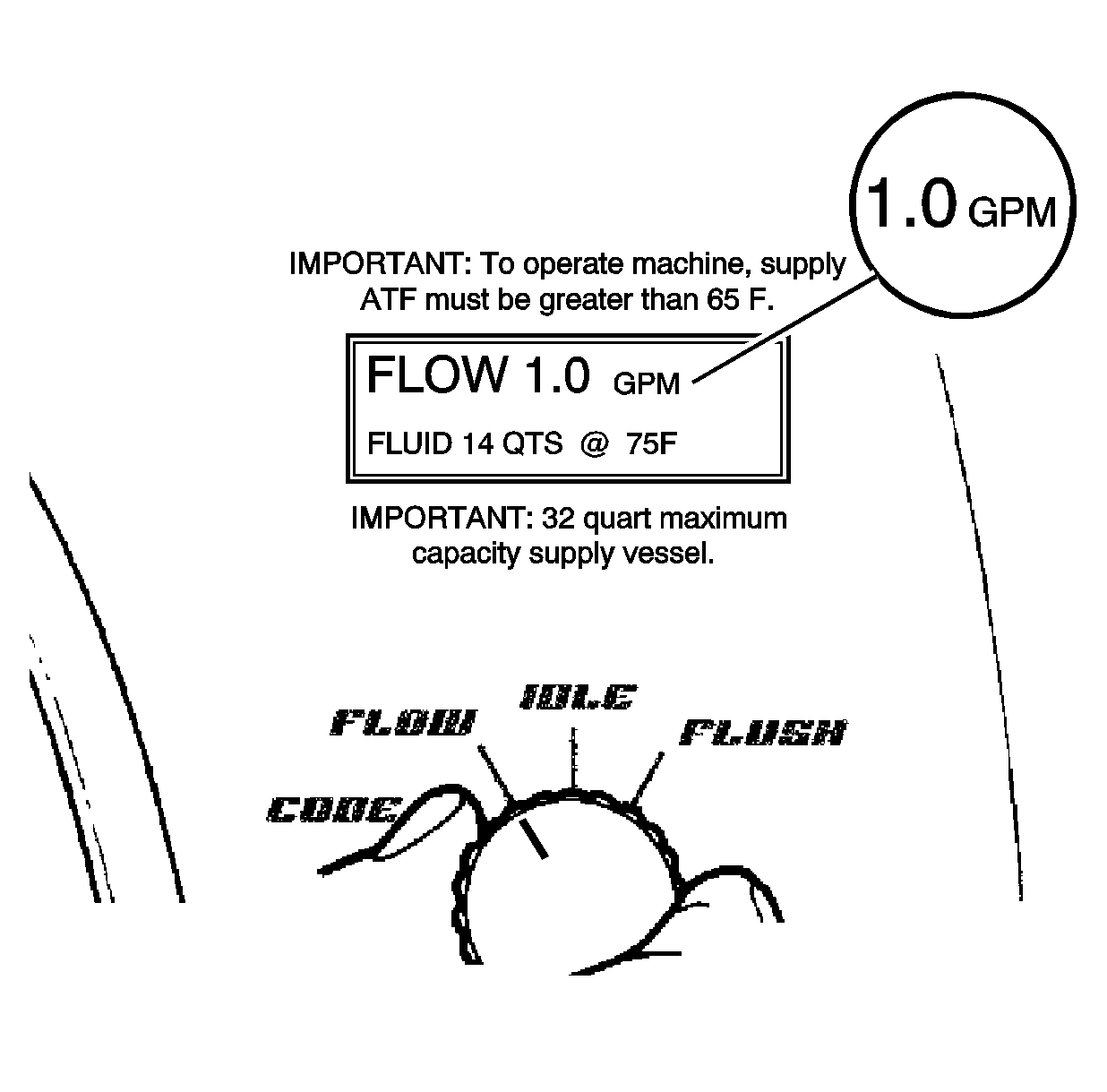
Important: If the flow rate is less than 0.5 gpm, the LCD displays an error message. Refer to the Troubleshooting section of the operation manual.
| • | If the TESTED flow rate is equal to or greater than the MINIMUM flow rate recorded, the oil cooling system is functioning properly. Perform Code Recording Procedure. |
| • | If the TESTED flow rate is less than the MINIMUM flow rate previously recorded, repeat the back flush and forward flush procedures. |
| 3.1. | Replace the transmission oil cooler. |
| 3.2. | Connect the supply and waste hoses to the cooler lines in the normal flow direction. Perform the Flow Test. |
| 3.3. | Perform the Code Recording Procedure. |
Code Recording Procedure
- Turn the main function switch to the CODE position.
- Record TESTED flow rate, temperature, cycle and seven-character flow code information on the repair order.
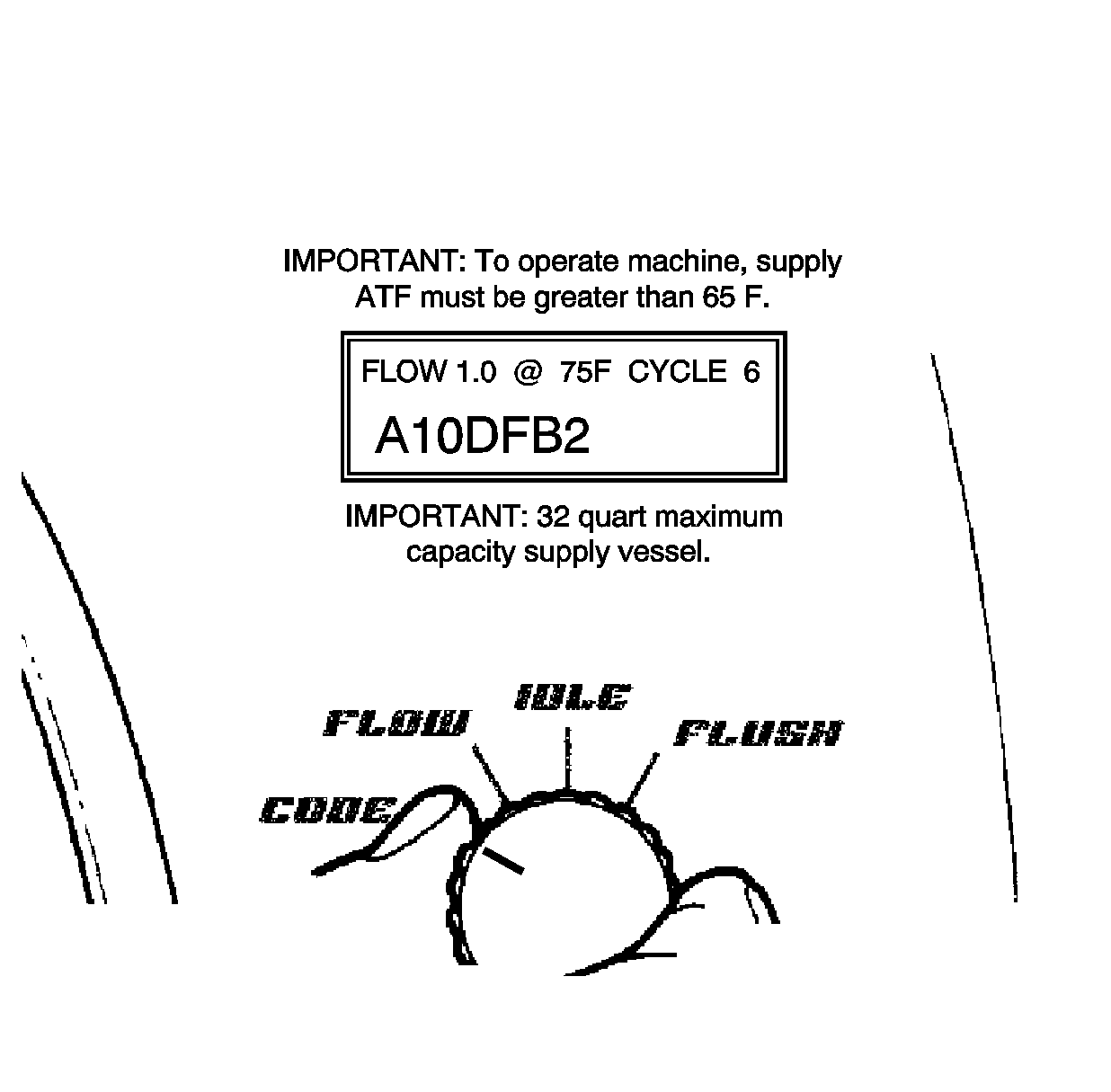
Important:
• If power is interrupted prior to the recording of the seven-character code, the code will be lost and the flow rate test will need to be repeated. • The flow test must run for a minimum of 8-10 seconds and be above 0.5 gpm for a code to be generated.
Clean-Up
- Turn the main function switch to the IDLE position and allow the supply vessel pressure to dissipate.
- Turn the main power switch to the OFF position.
- Disconnect the supply and waste hoses and the 12-volt power source from the vehicle.
- Disconnect the air supply hose from J 45096 .
- Dispose of the waste ATF in accordance with all applicable federal, state, and local requirements.

Important: A small amount of water may drain from the bottom of the unit when the air supply is disconnected. This is a normal operation of the built-in water separator.

Transmission Fluid Cooler Flushing and Flow Test J-35944-A
GM studies indicate that plugged or restricted transmission oil coolers and pipes cause insufficient transmission lubrication and elevated operating temperatures which can lead to premature transmission wear-out. Many repeat repair cases could have been prevented by following published procedures for transmission oil cooler flushing and flow checking. This procedure includes flow checking and flushing the auxiliary transmission oil cooler, if equipped.
The tool may be adapted for use on this vehicle by dealership personnel with a barbed hose connector and rubber hose obtained locally. This transmission has a transmission oil requirement which maybe slightly different than DEXRON® III ATF. However, flushing the cooler with DEXRON® III automatic transmission fluid is an acceptable service procedure. Very little fluid remains in the cooler after the flush procedure and the residual DEXRON® III ATF in the cooler is compatible with this vehicle's transmission fluid.
Important: Use the
J 35944-A or equivalent to flush the transmission oil cooler and the oil cooler pipes whenever the transaxle is removed for the following repairs:
• Torque converter • Oil pump • Oil pump drive shaft • Drive sprocket support • Transaxle overhaul complete • Transaxle assembly replacement
Important: Only use the specified automatic transmission fluid after doing a repair on this transmission. Refer to Fluid and Lubricant Recommendations
Cooler Flow Check and Flushing Steps
- Tools Required
- Preparation
- Back Flush
- Forward Flush
- Flow Check
- Clean-up
Tools Required
| • | J 35944-22 Transmission Oil Cooler Flushing Fluid |
| • | Measuring cup |
| • | Funnel |
| • | Water supply - hot water recommended |
| • | Water hose, at least 16 mm (5/8 in) ID |
| • | Shop air supply with water/oil filters, regulator and pressure gage |
| • | Air chuck with clip, if available |
| • | Oil drain container |
| • | Pail with lid 19 L (5 gallon) |
| • | Eye protection |
| • | Rubber gloves |
Preparation
- During the installation of the repaired or replacement transmission, do not connect the oil cooler pipes.
- Remove the fill cap (9) on the J 35944-A and fill the flusher tank (4) with 0.6 L (20-21 oz) of J 35944-22 , using the measuring cup (6). Do not overfill.
- Install the fill cap (9) on the J 35944-A and pressurize the flusher tank (4) to 550-700 kPa (80-100 psi), using the shop air supply at the tank air valve (2).
- With the water supply valve (1) on the J 35944-A in the OFF position, connect the water supply hose from the J 35944-A to the water supply at the faucet.
- Turn ON the water supply at the faucet.
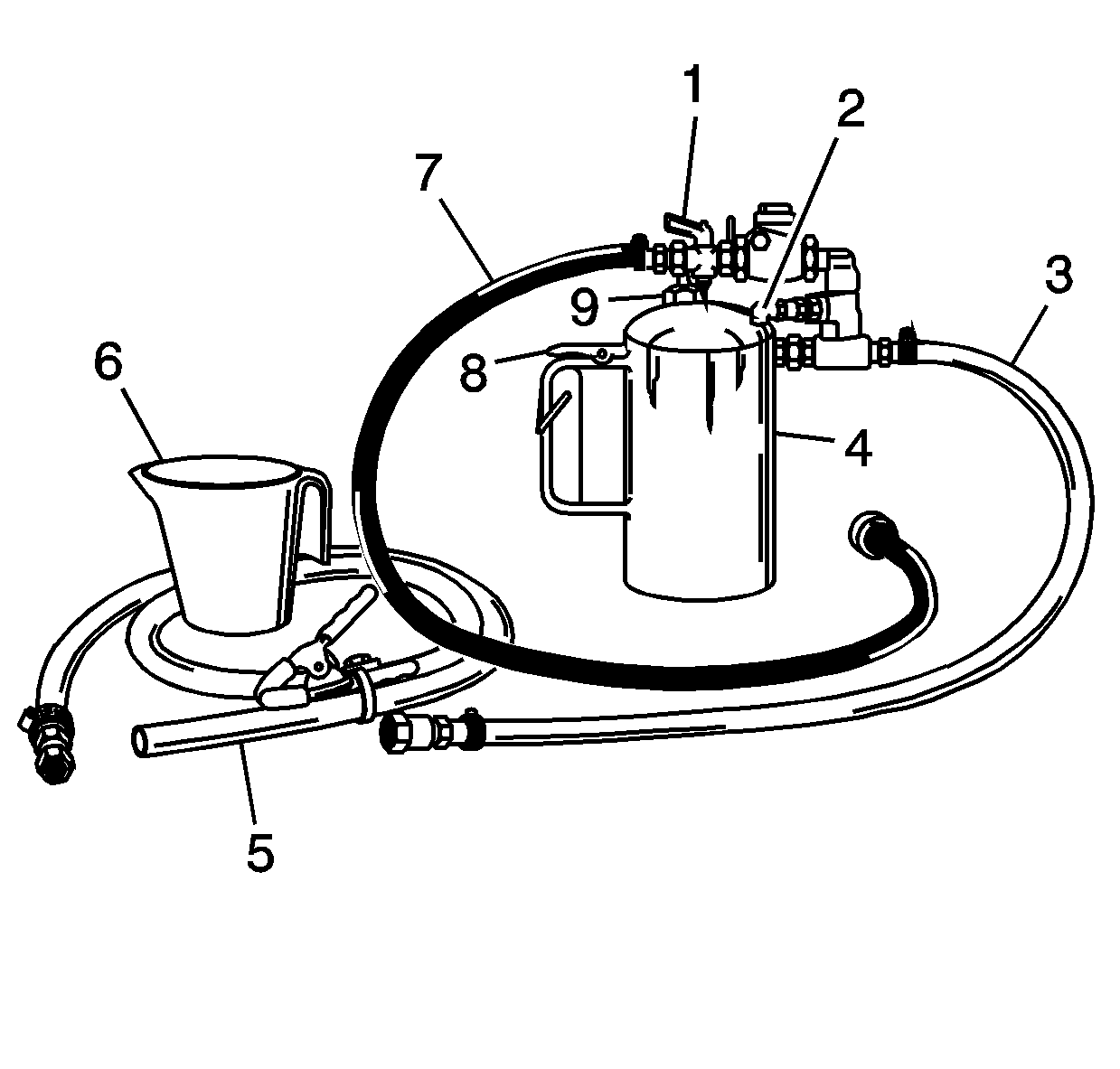
Notice: Do not use solutions that contain alcohol or glycol. Use of solutions that contain alcohol or glycol may damage the oil cooler line flusher, oil cooler components and/or transmission components.
Important: The J 35944-22 is environmentally safe, yet powerful enough to cut through transmission fluid to dislodge any contaminants from the cooler. The safety precautions on the label, regarding potential skin and eye irritations associated with prolonged exposure, are typical precautions that apply to many similar cleaning solutions. It should be noted that according to GM, use of other non-approved fluids for cooler flushing can have an adverse reaction to the seals inside the transmission.
Back Flush
- Inspect the transmission oil cooler pipes for kinks or damage. Repair as necessary.
- Connect the J 35944-A to the oil cooler feed bottom connector. Use the J 35944-600 , if required.
- Clip the discharge hose (2) onto the oil drain container.
- Attach the J 35944-A to the undercarriage of the vehicle with the hook provided and connect the flushing system feed supply hose (1) from the J 35944-A to the top connector oil cooler return pipe. Use the J 35944-600 , if required.
- Turn the J 35944-A water supply valve (3) to the ON position and allow water to flow through the oil cooler and pipes for 10 seconds to remove any remaining transmission fluid. If water does not flow through the oil cooler and pipes, the cause of the blockage must be diagnosed and the plugged component must be repaired or replaced. Continue with the cooler flushing and flow check procedure once the blockage is corrected.
- Turn the J 35944-A water supply valve (3) to the OFF position and clip the discharge hose onto a 19 liter (5 gallon) pail with a lid, to avoid splashback.
- Turn the J 35944-A water supply valve (3) to the ON position and depress the trigger (1) to mix cooler flushing solution into the water flow. Use the clip provided on the handle to hold the trigger (1) down. The discharge will foam vigorously when the solution is introduced into the water stream.
- Flush the oil cooler and pipes with water and solution for 2 minutes. During this flush, attach the shop air supply 825 kPa (120 psi) to the flushing system feed air valve (2) located on the J 35944-A , for 3-5 seconds at the end of every 15-20 second interval to create a surging action.
- Release the trigger (1) and turn the J 35944-A water supply valve (3) to the OFF position.
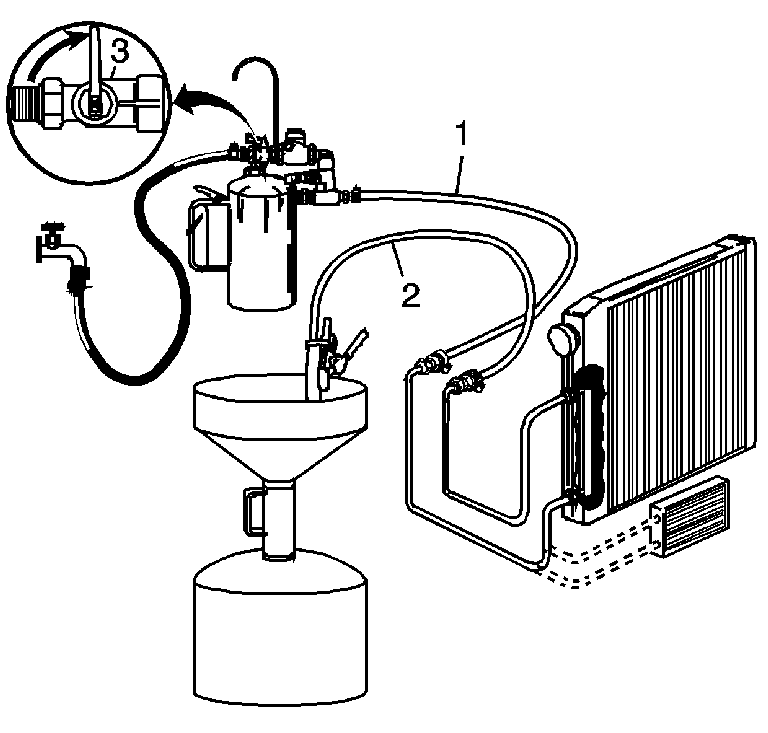

Important: Flushing for approximately 2 minutes in each cooler line direction will result in a total of about 8-10 gallons of waste fluid. This mixture of water and flushing fluid is to be captured in a bucket or similar container.
Forward Flush
- Disconnect both hoses (1 and 2) from the oil cooler pipes and connect them to the opposite oil cooler pipe. This will allow the oil cooler and pipes to be flushed in the normal flow direction.
- Repeat Step 6 and 7 of the Back Flush.
- Release the trigger (1) of the J 35944-A and allow water only to rinse the oil cooler and pipes for 1 minute.
- Turn the J 35944-A water supply valve (3) to the OFF position and turn OFF the water supply at the faucet.
- Attach the shop air supply to the flushing system feed air valve (2) on the J 35944-A and blow out the water from the oil cooler and pipes. Continue, until no water comes out of the discharge hose.


Flow Test
- Disconnect the hose from the oil cooler pipe. Connect the oil cooler feed pipe, bottom connector, to the transmission for normal flow.
- Clip the discharge hose (1) to an empty oil container.
- Confirm the transmission is filled with automatic transmission fluid. Refer to Fluid Capacity Specifications for the correct automatic transmission fluid capacity.
- Start the engine with the transmission in PARK range and run for 30 seconds after fluid begins to flow from the discharge hose (1). A minimum of 1.9 L (2 quarts) must be discharged during this 30 second run time.
- If the fluid flow meets or exceeds 1.9 L (2 quarts) in 30 seconds, connect the oil cooler feed pipe to the bottom connector on the transmission.
- If fluid flow is less than 1.9 L (2 qt) in 30 seconds, perform the following diagnosis:
- If the amount of transmission fluid flow remains less than 1.9 L (2 qt) in 30 seconds, inspect the oil cooler feed pipe, bottom connector, for restrictions or damage. If no condition is found with the feed pipe, bottom connector, inspect the transmission.
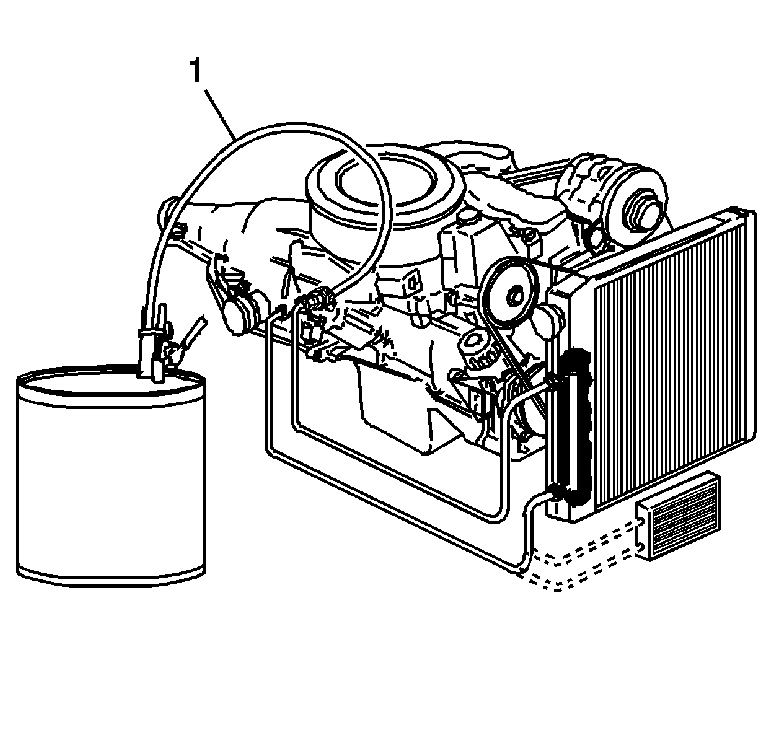
Important: The Flow Test must be performed after the flush to ensure that all flushing solution and water is removed from the oil cooling system.
| 6.1. | Disconnect the J 35944-A discharge hose (1) from the oil cooler return pipe. |
| 6.2. | Disconnect the oil cooler feed pipe at the radiator. |
| 6.3. | Connect the J 35944-A discharge hose (1) to the oil cooler feed pipe, radiator end. |
| 6.4. | Clip the discharge hose (1) onto the oil drain container. |
| 6.5. | Start the engine with the transmission in PARK range and run for 30 seconds after fluid begins to flow from the discharge hose (1). A minimum of 1.9 L (2 qt) must be discharged during this 30 second run time. |
Clean-up
- Disconnect the water supply hose from the J 35944-A and bleed any remaining air pressure from the flusher tank.
- Remove the fill cap from the J 35944-A and return any unused flushing solution to its container. Rinse the J 35944-A with water. Do not store the J 35944-A with flushing solution in it.
- After every third use, clean the J 35944-A as described in the instructions included with the tool.
- Dispose of any waste water/solution and transmission fluid in accordance with local regulations.
